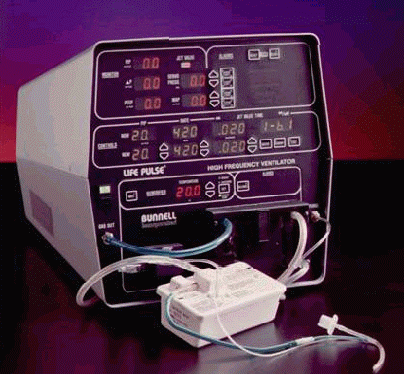
Use of the Jet Ventilator
| Indications
Setup Application HOTLINE 800-800-4358 |
 |
BWH
NICU
Use of the Jet Ventilator
|
||
graphic of control box
graphic of ett and connector
Baseline settings: rate 420 I-time 0.02 sec
Conventional (CVL: rate 0-3, PIP 15-20,
The benefits of increasing background CV breaths during HFJV decrease quickly at rates higher than 10 bpm.
Changes as lung volume changes.
Increases with improved compliance, air leak
Decreases with worsended compliance, tension pneumo, ETT obstruction.
Optimal PEEP (use graphic)
Positive End Expiratory Pressure (PEEP) is an operator-controlled variable
during mechanical ventilation that can be beneficial or detrimental depending
on how it is used. Too little PEEP may result in airway and alveolar collapse.
Too much PEEP and MAP may cause alveolar overdistension and create numerous
hemodynamic problems.1
An important ventilator strategy is to find and use optimal PEEP. Optimal PEEP is the PEEP level that will provide the best blood gases with the least detrimental impact on cardiopulmonary function.
An xray can reveal much about PEEP levels. You may be able to determine inadequate PEEP by the appearance of atelectasis or poor expansion. Excessive PEEP can manifest its iatrogenic consequences as overdistension on xray or decreased cardiac output. Determining optimal PEEP is crucial and will change from patient to patient, from pathophysiology to pathophysiology, and depending upon the stage and severity of the disease.

Remember the two golden rules of ventilation when determining optimal PEEP during HFJV. Know your ventilators. Understand that the PEEP displayed on the Life Pulse is measured distally, inside the trachea, while the PEEP displayed on the conventional ventilator is a proximal value. A discrepancy between the two displays may be your first alert that the baby's pathophysiology is changing. For example, as lung compliance improves, the Life Pulse delivers larger tidal volumes to meet the set PIP. The greater the volume of gas going into the lungs, the longer it takes to get the gas out of the lungs. The displayed PEEP on the Life Pulse may begin to rise while the displayed CV PEEP remains unchanged. This discrepancy allows you to detect inadvertent PEEP and may be an early indication that the Life Pulse rate needs to be lowered to allow more expiratory time.
Know your patient. The PEEP and MAP should be higher if atelectasis is a primary concern and lower if air leaks or impaired hemodynamics 6 are primary concerns. Make logical decisions about a baby's appropriate PEEP levels. Be able to determine when the baby is getting too little or too much PEEP.